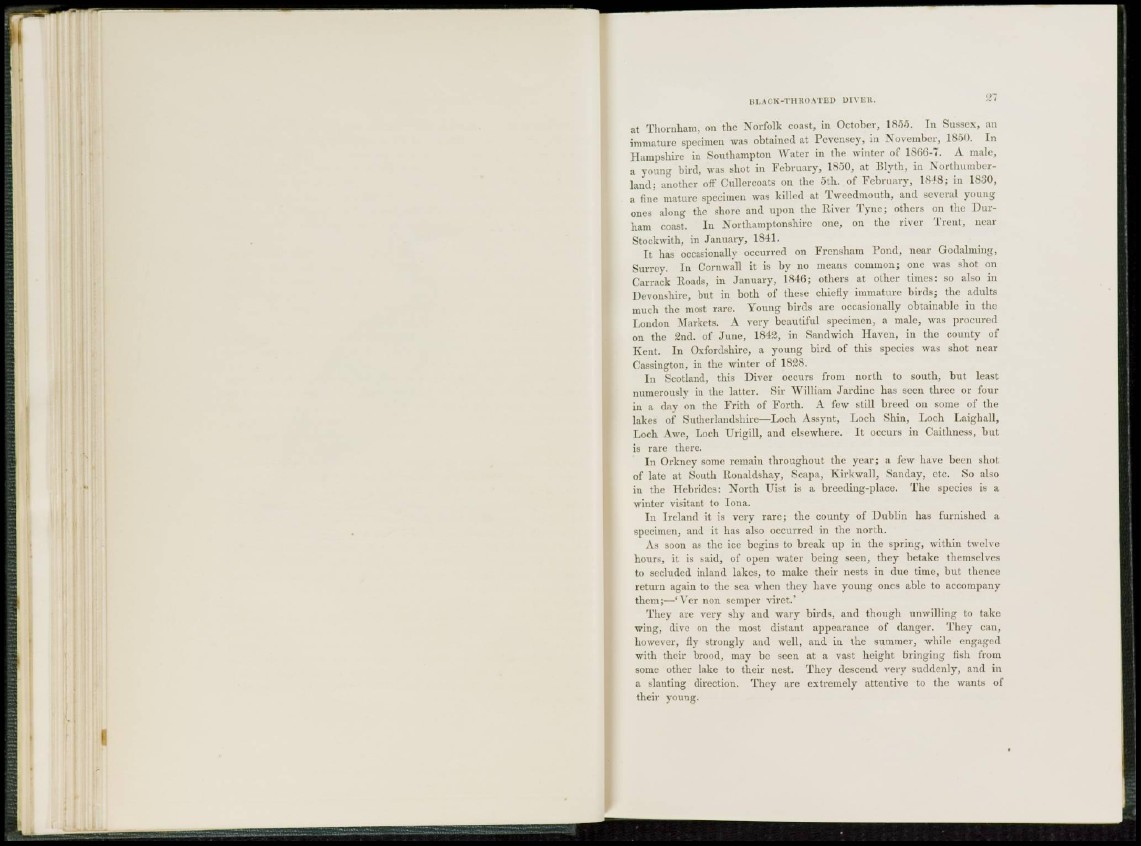
at Thornham, on the Norfolk coast, in October, 1855. In Sussex, an
immature specimen was obtained at Pevcnsey, in November, 1850. In
Hampshire in Southampton Water in the winter of 18(i(i-7. A male,
a young bird, was shot in F e b r u a r y , 1850, at Blyth, in N o r t h u m b e r l
a n d ; another off Cullcrcoats on the 5th. of F e b r u a r y , 1848; in 1830,
a fine mature specimen was killed at Tweedmouth, and several young
ones along the shore and u p o n the River T y n e ; others on t h e Durham
coast. In Northamptonshire one, on the river Trent, near
Stockwith, in J a n u a r y , 1841.
I t has occasionally occurred on F r e n s h am Pond, near Godalming,
Surrey. In Cornwall it is by no means common; one was shot on
Carrack Roads, in J a n u a r y , 1846; others at other times; so also in
Devonshire, but in both of these chiefly immature b i r d s ; the adults
much the most rare. Young birds arc occasionally obtainable in the
Loudon Markets. A very beautiful specimen, a male, was procured
on the 2nd. of J u n e , 1842, in Sandwich Haven, in the county of
Kent. In Oxfordshire, a young bird of this species was shot near
Cassington, in the winter of 1828.
I n Scotland, this Diver occurs from north to south, but least
numerously in the latter. Sir W i l l i am J a r d i n e has seen t h r e e or four
in a day on the F r i t h of F o r t h . A few still breed on some of the
lakes of Sutherlandshire—Loch Assynt, Loch Shin, Loch Laighall,
Loch Awe, Loch TJrigill, and elsewhere. It occurs in Caithness, but
is rare there.
I n Orkney some remain t h r o u g h o u t the year; a few have been shot
of late at South Etonaldshay, Scapa, Kirkwall, Sanday, etc. So also
i n the H e b r i d e s : N o r t h List is a breeding-p l a c e . The species is a
winter visitant to Iona,
I n Ireland it is very rare; the county of D u b l i n has furnished a
specimen, and it has also occurred in the n o r t h.
As soon as the ice begins to b r e a k up in the spring, within twelve
hours, it is said, of open water being seen, they betake themselves
to secluded inland lakes, to make their nests in due time, b u t thence
r e t u r n again to the sea when they have young ones able to accompany
t h e m ; — ' Y c r non semper virct.'
T h e y are very shy and wary b i r d s , and though unwilling to take
wing, dive on the most distant appearance of danger. They can,
however, fly strongly and well, and in the summer, while engaged
with their brood, may be seen at a vast height bringin g fish from
some other lake to their nest. They descend very suddenly, and in
a slanting direction. They are extremely attentive to the wants of
their young.